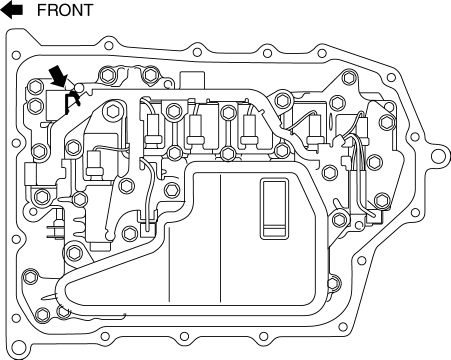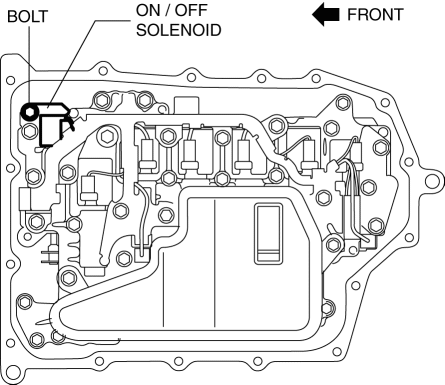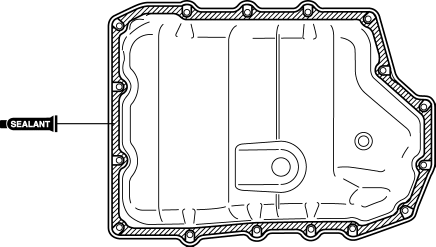Mazda CX-5 Service & Repair Manual: On/Off Solenoid Removal/Installation [Fw6 A EL, Fw6 Ax EL]
WARNING:
-
A hot transaxle and ATF can cause severe burns. Turn off the engine and wait until they are cool.
-
Always wear protective eye wear when using the air compressor. If the air compressor is used, any particles of dirt or soiling could spatter and get into the eyes.
1. Disconnect the negative battery cable..
2. Remove the front under cover No.2..
3. Clean the transaxle exterior throughout with a steam cleaner or cleaning solvents.
4. Drain the ATF..
5. Remove the oil pan.
CAUTION:
-
To avoid damaging the control valve body, if there is a large amount of foreign material at the bottom of the oil pan when the oil pan is removed, replace the oil strainer with a new one.
-
If there is not a large amount of foreign material at the bottom of the oil pan, the oil strainer does not have to be replaced.
6. Disconnect the ON/OFF solenoid connector.
NOTE:
-
Disconnect the ON/OFF solenoid connector by pressing the connector tab with your fingers.

7. Remove the ON/OFF solenoid.

8. Install the ON/OFF solenoid.

-
Tightening torque
-
9—10 N·m {92—101 kgf·cm, 80—88 in·lbf}
9. Connect the ON/OFF solenoid connector.

10. Apply a light coat of silicon sealant (TB1217E) to the contact surfaces of the oil pan and transaxle case.

CAUTION:
-
Clean any remaining silicone sealant on the contact surface of the transaxle case and oil pan, and degrease the sealant area. Otherwise, oil could leak.
11. Install the oil pan with new bolts before the applied sealant starts to harden.
-
Tightening torque
-
8—10 N·m {82—101 kgf·cm, 71—88 in·lbf}
12. Install the front under cover No.2..
13. Add the ATF..
14. Connect the negative battery cable..
15. Perform the “Mechanical System Test”..
 Oil Seal (Control Valve Body) Replacement [Fw6 A EL, Fw6 Ax EL]
Oil Seal (Control Valve Body) Replacement [Fw6 A EL, Fw6 Ax EL]
1. Disconnect the negative battery cable..
2. Remove the air cleaner component..
3. Disconnect the control valve body connector.
CAUTION:
Make sure that your hand does not touch the ...
 On/Off Solenoid [Fw6 A EL, Fw6 Ax EL]
On/Off Solenoid [Fw6 A EL, Fw6 Ax EL]
Purpose/Function
The on/off solenoid performs switching of the shift valve in the control
valve body according to the vehicle conditions.
Construction
The on/off solenoid is ins ...
Other materials:
Rear Window Defroster/Outer Mirror Heater
Outline
Fogging is cleared from the rear window and outer mirror glass by heating
of the filament.
Structural view
System wiring diagram
Vehicles with full-auto air conditioner system
Vehicles with manual air conditioner system
Construction
Rear window defroster
...
Adaptive Front Lighting System (Afs) Off Switch Inspection
1. Disconnect the negative battery cable..
2. Remove the switch panel..
3. Verify that the resistance between AFS OFF switches B and C is as indicated
in the table.
If the resistance can be verified as indicated in the table, go to the next
step.
If not as indicated ...
Room Straight Line Dimensions (1) [Dimensions]
Point symbol
Designation
Hole diameter or bolt or nut size mm {in}
A
Front pillar inner datum hole
?7 {0.3}
B
Front pillar inner datum hole
?7 {0.3}
C
...
